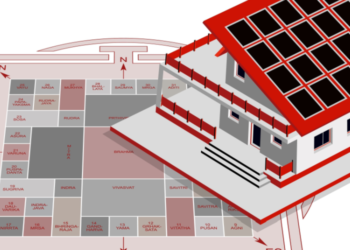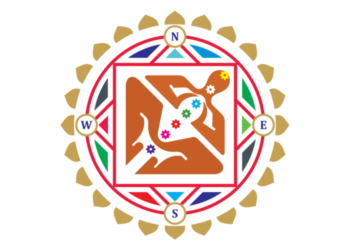The principles of Vastu Shastra have been followed from ancient days. But, it has gained popularity in recent times. More and more people are voluntarily showing interest in several aspects of Vastu shastra. And, one among them is attracting good fortune through Vastu Shastra Plants and Trees. Most of the abodes these days have a garden area. And, if not, indoor gardening is the best way to make Vastu plants a part of your home.
Benefits of keeping Vastu Shastra Plants and Trees:
Vastu plants, if placed in the right direction, can bring good health and prosperity. They have a significant impact on our mood.
Vastu plants, if placed in an outdoor garden, help you to connect with nature. You can enjoy the serenity and calmness of the surrounding.
As per Vastu Shastra, Vastu plants help in energizing the surrounding with positive energy.
Let us talk about a few ways to enhance luck through Vastu Shastra Plants and Trees.
Location of the Garden:
As per the Vastu experts, each segment of a garden resembles one of Paanch Maha Boota’s five components. The south-west part of the house addresses earth, the north-east records for water, the south-east represents fire (home to illness-free plants), while the north-west addresses air. The middle of the garden represents space. A nursery in the south-east or south-west causes worry and stress. Thus, the garden’s location equally plays a vital role along with the placement of Vastu Shastra Plants and Trees at home.
On the off chance, if the garden is in the front yard, a gigantic tree should never hinder the entrance. However, one can always plant a tree alongside the wall of the garden. So, which Vastu Shastra Plants and Trees can you choose? According to Vastu Shastra, you can plant mango, peepal, neem or a banana tree. These trees are preferred for their aroma as well as for the positive vibes they give out.
Ideal directions for Vastu Shastra Plants and Trees:
Avoid planting trees in the north-east direction. Little bushes must occupy the east or north corner of the garden.
Plant giant trees in the west, south and south-west direction of the garden. The only precaution you must take is the distance between the main house and the Vastu Shastra Plants and Trees. According to Vastu Shastra, their shadow shouldn’t fall on the building from 9.00 am to 3.00 pm.
Avoid planting peepal trees closeby to the house as their roots might damage the house’s foundation. You should equally avoid planting trees that attract serpents, insects, bees or worms. This is because they attract bad luck apart from being a threat to human life. You can also get in touch with Vastu consultants to know more about Vastu Shastra Plants and Trees.
Suitable Vastu Plants and Trees:
Vastu experts recommend a few Vastu Shastra Plants and Trees that are a must in the house. These plants are sure to attract positivity in the lives of the residents. A few suitable Vastu plants are holy basil(commonly known as Tulsi), lucky bamboo, money plant, rose, and lily. The banana tree and neem tree are the other options to be considered.
The Holy Basil:
If you have holy basil or are planning to place holy basil, choose the house’s northern, north-eastern, and eastern direction. Place the plant in such a way that it gets ample amount of sunlight. Water the Tulsi plant regularly. This medicinal plant also serves as a natural air-purifier and toxin-remover from blood.
The Money Plant:
As the name signifies, it is related to the family’s financial status. The plant symbolizes wealth and prosperity. Place the plant at the corners of the north or east direction. Avoid keeping the plant near the headrest or the single or double bed’s footrest.
The Lucky Bamboo Plant:
The best direction for keeping the bamboo plant is the north or east direction of the house. You can also consider your bedroom to place the lucky bamboo plant. Keep it on the table either on the left or right-hand side of the bed.
The Neem Tree:
The best direction for keeping the Neem tree is the Northwest corner of the house. According to the Vastu principles, it is among the best Vastu Shastra Plants and Trees as it has got medicinal properties too.
The Banana tree:
Keep the Banana plant in the northeast direction of the house. This right direction of the Banana plant helps in maximizing the health and wealth benefits
As per Vastu Shastra, plants with thorns are a strict no. The thorny plants attract negative energy; hence plants like cactus should be avoided. The only exception to thorny plants is the rose plant.
Most of the houses have flower pots placed on the compound wall. Vastu disapproves of this as it increases the height of the compound wall. The best direction for flower plants is north, east or north-east direction.
Garden as per Vastu Shastra guidelines:
Most of the gardens have benches. These benches can be placed in the east or north. This is to ensure that people sitting in these benches face the east or the west direction.
Construct a mini waterfall in the east or north direction. As per Vastu consultants, having a waterfall in the wrong direction will negatively impact mental peace. If you have a swimming pool in the garden or are planning to have one, construct it in the north or north east direction.
Construct a mini pond with lotuses in them. This will bring fortune.
These are a few tips that you must consider for Vastu Shastra Plants and Trees. You may not experience immediate results, but gradually you’ll feel the difference. There are many households where they have a well-maintained garden with beautiful plants but aren’t Vastu-compliant. Thus, follow these simple yet useful tips to attract peace, prosperity and happiness.
Do you have Vastu Shastra Plants and Trees in your home? Yes? Do share the names with us.










